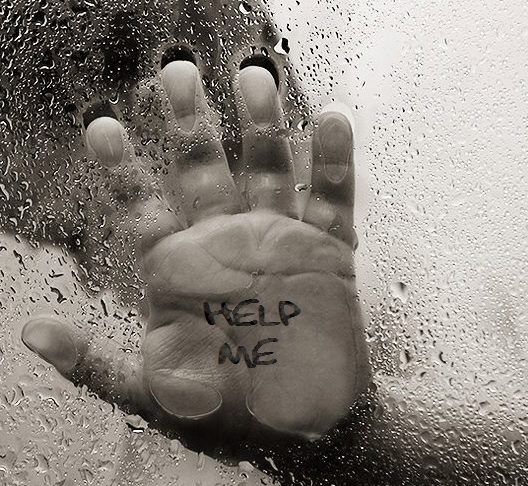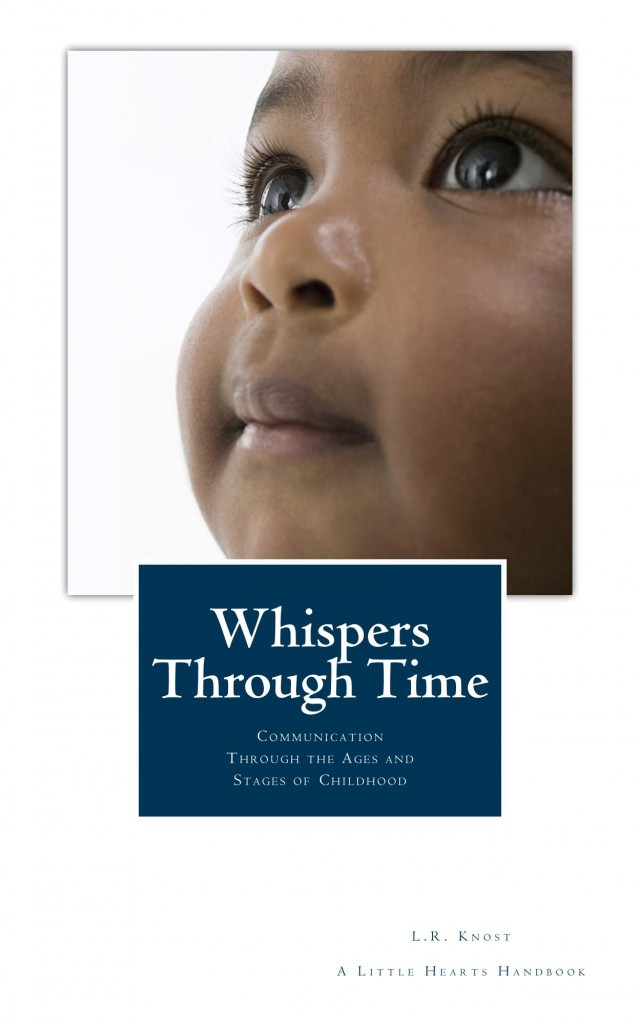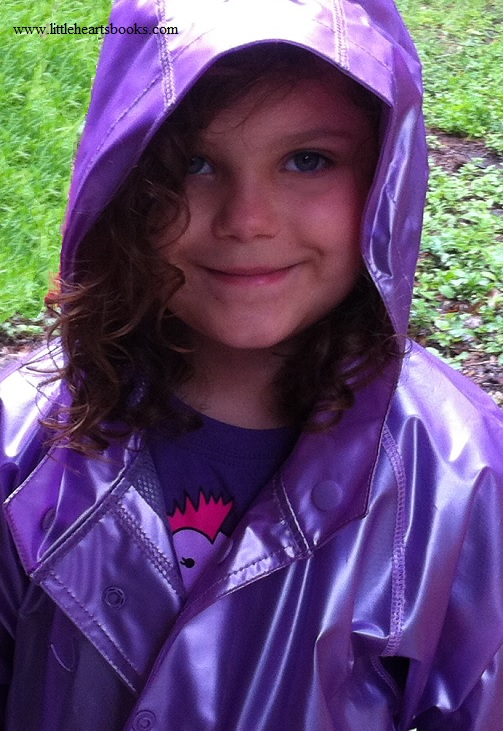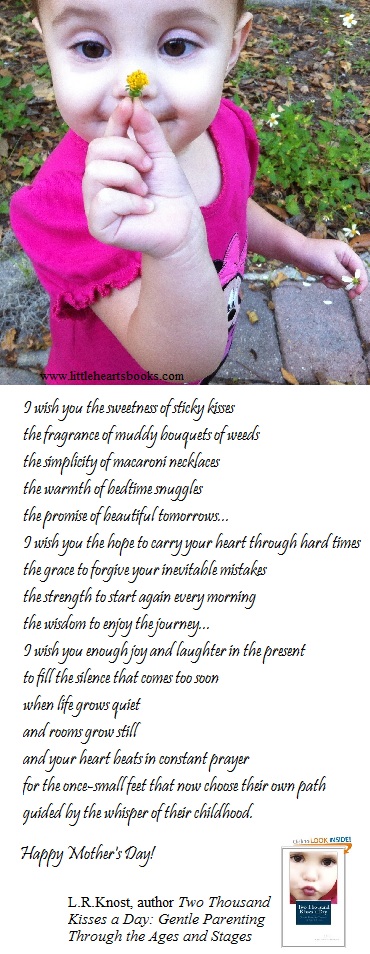[Reprinted from Whispers Through Time: Communication Through the Ages and Stages of Childhood by L.R.Knost. Two Thousand Kisses a Day: Gentle Parenting Through the Ages and Stages and The Gentle Parent: Positive, Practical, Effective Discipline also available through Amazon and other major retailers.]
 With more than 90% of parents admitting to spanking or otherwise physically punishing their children at least occasionally, mainstream American parenting can certainly be defined as punitive. If you go to the library or browse the shelves at Barnes & Noble or check out Amazon’s best sellers in the parenting genre, you will find a predominance of popular, punishment-based, obedience-focused parenting guides. Whether its spanking or time outs or removal of privileges or time confined in their room, the vast majority of children in the United States are raised with punitive parenting.
With more than 90% of parents admitting to spanking or otherwise physically punishing their children at least occasionally, mainstream American parenting can certainly be defined as punitive. If you go to the library or browse the shelves at Barnes & Noble or check out Amazon’s best sellers in the parenting genre, you will find a predominance of popular, punishment-based, obedience-focused parenting guides. Whether its spanking or time outs or removal of privileges or time confined in their room, the vast majority of children in the United States are raised with punitive parenting.
When it comes to children talking back to parents, many of these punitive parenting guides dictate a zero-tolerance policy. By their definition, backtalk is often characterized as verbal or emotional abuse of parents, defiance, rudeness, or threats:
- Verbal or emotional abuse of parents is considered any statement that insults or hurts a parent such as, “You’re so mean!” or “I wish I didn’t even have parents!” or “I hate you!”
- Defiance is any statement containing the word “No” in response to a parental command.
- Rudeness is defined as anything from deep sighs to rolled eyes to stomped feet.
- Threats are any statements that give conditions such as, “If you take away my cell phone, I’ll just go get a new one!” or “If you don’t drive me to my friend’s house, I’m walking there!”
These parenting guides direct parents to decide which punishment to mete out when their child talks back to them, specifying that the deciding factor should be whichever punishment would be the most unpleasant, painful, and distressing for the child. Punishments are to be carried out swiftly and without discussion. When the retribution for the child’s actions is over, it is to be followed with a lecture laying down the laws of the family. Again, no discussion is allowed, but if the child expresses appropriate penitence, love and hugs can then be offered.
In addition to the sick feeling in the pit of my stomach at the thought of children being subjected to this kind of harsh, punitive parenting, I’m saddened by the upside-down reasoning that shuts communication down instead of utilizing it to bring healing, understanding, and restoration to the parent/child relationship.
Take a look at the order of parenting prescribed: First, punishment meted out by the parent. Second, lecture delivered by the parent. Third, conditional reconnection based on a proper expression of remorse to the parent from the child.
In gentle parenting, the order and intent of parenting would be the polar opposite: First would come listening for the need behind the behavior and reconnecting with the child at the point of need. Second, would be initiating a two-way communication about the problem and brainstorming about how to address the issue in ways that will meet everyone’s needs. Third, would be offering guidance and equipping the child with better ways to express needs in the future.
The punitive parenting approach focuses on the child as the problem and attempts to solve the problem by ‘fixing’ the child through intentionally unpleasant external forces.
The gentle parenting approach focuses on the child having a problem and attempts to help the child solve the problem through connection, communication, and inviting cooperation.
Now look at the definitions of backtalk–verbal and emotional abuse of parents, defiance, rudeness, and threats. The questions that immediately arise are: What about the parents? Are they held to the same standards as the children? Or do they threaten? Do they say ‘No’? Do they sigh? Do they hurt their children?
As parents, our actions will always be reflected in our children’s behavior. Children learn what they live. No amount of lecturing can undo the powerful impact on a child of their parent’s own behavior and choices.
When a child backtalks, sometimes also referred to as mouthing-off or sassing, they are in the throes of a huge, internal maelstrom of emotion. Whatever they are reacting to in the moment, whether it’s being told ‘no’ about something or being asked to do or not do something, it is rarely those issues that are at the root of the problem. The moment at hand is just the tipping point causing a fissure in the child’s heart that lets out a bit of the steam inside. The real concern should be that there is, metaphorically, steam in the child’s heart to begin with.
It is at this point that parents have the opportunity to model self-control and self-regulation by controlling their own knee-jerk reaction to their child’s backtalk. Instead of meeting fire with fire, childish outburst with childish parental outburst, child’s tantrum with adult tantrum, parents can slow down, breathe through their own emotions, and then listen through the fiery storm of their child’s words to the hurt, fear, and anger behind the words.
In the same way that “a gentle answer turns away wrath,” a soft-voiced, “Let’s take a minute and calm down so we can work through this together, okay?” from a parent is a magical, healing balm that immediately begins to diffuse tough situations and creates an atmosphere in which connection and communication can bring effective, peaceful solutions not only to the issue at hand, but to the inner turmoil that prompted the outburst in the first place.
Meeting a child at their point of need when that need is expressed through meltdowns, yelling, disrespect, or defiance takes patience, self-control, and empathy on the part of a parent, which can be a huge growth experience for the parent if they, themselves, were not parented that way. But the impact of living those positive life skills in front of our children is immeasurable.
Parenting isn’t a perfect science and parents aren’t perfect people, but creating an overall atmosphere of respect in a home starts with the parents modeling respect in their own tone of voice, in their own reactions to stressful situations, in their own interactions with their children.
It’s not easy, for sure. But the best things, the most valuable things, in life rarely are. Working toward being understanding, available, and responsive to our children’s needs yields a priceless return in our relationship as the years fly by and adulthood looms. Not meeting those needs, though, may have serious negative consequences…
Dear Daughter,
You entered your teen years with a bang a few years ago, and the explosions have been shattering our home ever since. I’ve begged, threatened, bribed, and punished; cried, shouted, and bargained; but I just can’t find a way to reach you anymore. You constantly say I don’t listen to you, but how can I when you won’t talk to me? You say I don’t understand you, but how can I when you push me away? You say we aren’t a family, but then spend every day with earphones in your ears, blocking us out. You ask me why I hate you, then roll your eyes when I tell you I love you. How did it come to this? We used to be such a happy family. Please, let me be there for you during this huge transition in your life. Let’s really try to communicate with each other. I’m just lost here, honey, and I need you to reach out and help me reconnect with you. I love you.
Your Dad
‘Dear’ Dad,
Happy family? Are you kidding me? No, I guess not. You never did get it. Okay, you asked, so I’ll tell you. You were always happy because you were always in control. Want to know why I don’t talk to you now? Because you never listened when I was little. When I was scared in my room at night and called you, you either ignored me or threatened to spank me if I didn’t go to sleep. I’d lay there, crying so hard I’d almost throw up, terrified of the sounds and shadows in my room, but even more terrified of you. So, sorry, but I don’t buy that you’re ‘there for me’ when it’s only ever been at your own convenience. When you were mad at something I’d done and I tried to explain myself, you’d call it backtalk and smack me in the mouth. So forgive me if I don’t really believe you when you say you want to ‘communicate’ with me now. When I’d try to show you a dance I’d made up or tell you about how someone had pushed me on the playground, you couldn’t even be bothered to look away from your stupid computer while I was talking, so if I’m wrapped up in my electronics, I learned that little trick from you, Father Dear. Oh, and reconnect? Really? That implies that we were once connected. But when I was a little girl and invited you into my world and asked you to play with me, you were always too busy. So if you don’t understand me, sorry, but that invitation expired years ago. Want to know why I think you hate me? Because your actions told me so. Your ‘love’ is just words.
‘Your’ Daughter
Not all children react this way to harsh, punitive, control-based parenting, of course. Some children, due to personality, other influences and mentors in their lives, or simply as a survival instinct, will turn out okay despite how they are parented.
But ‘okay’ is too mediocre a goal when it comes to growing our children into the adults who will one day lead our world. Instead of raising children who turn out okay despite their childhood, let’s raise children who turn out extraordinary because of their childhood. Let’s grow excellent, outstanding, remarkable adults who will be world changers for the next generation and the generations to come.
Related posts:
When Children Act Out ~ Reflecting Our Emotions
Changing the World, One Little Heart at a Time
Practical, Gentle, Effective Discipline
 Award-winnning author, L.R.Knost, is the founder and director of the children's rights advocacy and family consulting group, Little Hearts/Gentle Parenting Resources, and Editor-in-Chief of Holistic Parenting Magazine. Books by L.R.Knost include Whispers Through Time: Communication Through the Ages and Stages of Childhood ; Two Thousand Kisses a Day: Gentle Parenting Through the Ages and Stages ; The Gentle Parent: Positive, Practical, Effective Discipline ; and Jesus, the Gentle Parent: Gentle Christian Parenting the first four books in the Little Hearts Handbook gentle parenting series, and children’s picture books Petey’s Listening Ears and the soon-to-be-released Grumpykins series.
Award-winnning author, L.R.Knost, is the founder and director of the children's rights advocacy and family consulting group, Little Hearts/Gentle Parenting Resources, and Editor-in-Chief of Holistic Parenting Magazine. Books by L.R.Knost include Whispers Through Time: Communication Through the Ages and Stages of Childhood ; Two Thousand Kisses a Day: Gentle Parenting Through the Ages and Stages ; The Gentle Parent: Positive, Practical, Effective Discipline ; and Jesus, the Gentle Parent: Gentle Christian Parenting the first four books in the Little Hearts Handbook gentle parenting series, and children’s picture books Petey’s Listening Ears and the soon-to-be-released Grumpykins series.


 A Toddler Speaks…
A Toddler Speaks… The life of a small child is comprised of a daily onslaught of tempting surfaces begging for the artistry of a crayon, tall places crying out to be scaled, lovely little objects in need of a mouth or nose to visit, and dozens of other alluring glass and liquid and sharp things to be explored through the physics of gravity, the kinetics of concoctions, and the application of Newton’s Laws of Motion. There is only one force powerful enough to defeat this nearly irresistible call of adventure, imagination, and discovery…the No!
The life of a small child is comprised of a daily onslaught of tempting surfaces begging for the artistry of a crayon, tall places crying out to be scaled, lovely little objects in need of a mouth or nose to visit, and dozens of other alluring glass and liquid and sharp things to be explored through the physics of gravity, the kinetics of concoctions, and the application of Newton’s Laws of Motion. There is only one force powerful enough to defeat this nearly irresistible call of adventure, imagination, and discovery…the No!
 Parents often ask how they can gently and effectively approach a parent who is berating or smacking or otherwise mistreating their child. While the reality is that there is no way to intervene without offending the parent, no matter how kindly it is done, that doesn’t necessarily mean we shouldn’t intervene. Obviously if we believe the child is in danger we should always contact the authorities immediately. Other times, though, there’s no real physical danger, but we can see the parent is out-of-control, is struggling with parenting, or is just too stressed or self-focused to care. What do we do then? Can we intervene in any meaningful, effective way? Should we even try?
Parents often ask how they can gently and effectively approach a parent who is berating or smacking or otherwise mistreating their child. While the reality is that there is no way to intervene without offending the parent, no matter how kindly it is done, that doesn’t necessarily mean we shouldn’t intervene. Obviously if we believe the child is in danger we should always contact the authorities immediately. Other times, though, there’s no real physical danger, but we can see the parent is out-of-control, is struggling with parenting, or is just too stressed or self-focused to care. What do we do then? Can we intervene in any meaningful, effective way? Should we even try? Four years ago today I lost my son, Sammy.
Four years ago today I lost my son, Sammy.
 Your sweet little four-year-old has suddenly started throwing his food at the table every. single. night. You’ve tried giving him smaller portions of food, letting him help plan the meals, letting him help cook the meals. You’ve tried asking him to stop, demanding that he stop, pleading with him to stop. You’ve tried rewards, sticker charts, and offering desserts. You’ve put him in time-out, yelled at him, even threatened to spank him, which you’ve never, ever done before. But still he throws food at the table.
Your sweet little four-year-old has suddenly started throwing his food at the table every. single. night. You’ve tried giving him smaller portions of food, letting him help plan the meals, letting him help cook the meals. You’ve tried asking him to stop, demanding that he stop, pleading with him to stop. You’ve tried rewards, sticker charts, and offering desserts. You’ve put him in time-out, yelled at him, even threatened to spank him, which you’ve never, ever done before. But still he throws food at the table. 







